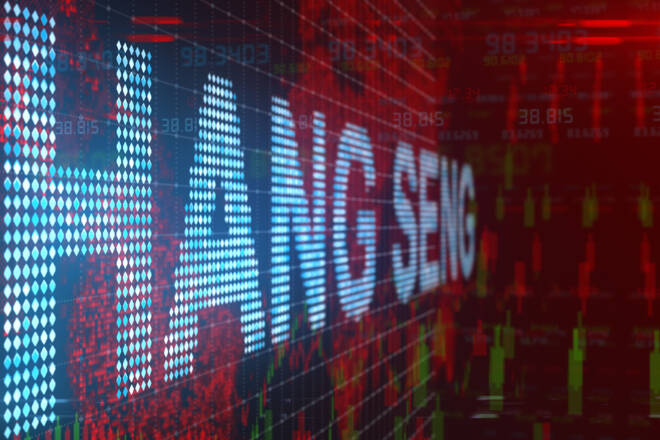Advertisement
Advertisement
Hang Seng Index: Rebounds After 13% Crash as Traders Eye US-China Tariff Risks
By:
Key Points:
- Trump threatens a 50% tariff hike on China, raising total US tariffs to a potential 104%, escalating trade tensions.
- China vows to retaliate firmly if the US enacts new tariffs, signaling a deepening impasse in trade talks.
- Hang Seng plunges 13.22%—its worst drop since 1997—before rebounding 1.58% on policy support and buybacks.
US Markets in a Rollercoaster Session on Tariff Shocks
US equity markets posted mixed results on Monday, April 7, amid fears of a full-scale global trade war. The Dow and the S&P 500 extended their losses from April 4, falling 0.91% and 0.23%, respectively, while the Nasdaq Composite Index gained 0.10%.
Markets briefly rallied on unverified reports of a tariff delay, which were later debunked—prompting sharp reversals, as noted by The Kobeissi Letter. Trump also threatened China with an additional 50% tariff if Beijing failed to withdraw its 34% tariff countermeasure by Tuesday, April 8, adding to the risk-off mood.
The Kobeissi Letter remarked on the market volatility:
“At 10:15 AM ET, US stocks swung $7 TRILLION in 30 minutes on a “fake” tariff deal headline. […] Sum this all up and we have a confirmation of no tariff delay and also HIGHER tariffs on China. Logically, this means the fundamental situation has deteriorated.”
Asian Market Implications: Asian equities opened the Tuesday, April 8, as investors assessed escalating tariff threats against prospects of diplomatic progress.
Hang Seng Index Steadies Amid Tariff Threats
In Asia, the Hang Seng Index rose 1.58% on Tuesday morning, partially reversing Monday’s 13.22% slump. Risk appetite improved amid hopes the US administration would negotiate trade terms with key trading partners.
However, China’s firm stand against US tariffs limited the morning gains. Beijing warned of further countermeasures if Washington follows through with an additional 50% tariff hike, potentially effective April 9. Beijing’s 34% counter-tariff will take effect on April 10 if the US imposes the levies.
Auto and tech stocks led the gains on April 8.
- The Hang Seng Technology Index advanced 2.43%.
- Tech giants Alibaba (09988.HK) and Baidu (09888.HK) posted gains of 1.38% and 3.25%, respectively.
- Li Auto Inc. (02015.HK) rose 2.50%, NIO Inc. (09866.HK) rallied 4.90%, and BYD Co. Inc. (01211.HK) surged 7.17%.
Mainland China’s equities also moved higher. The CSI 300 and Shanghai Composite Index advanced 0.96% and 0.91%, respectively.
Brian Tycangco, editor and analyst at Stansberry Research, remarked on market conditions, stating:
“Still no word on a huge direct fiscal stimulus to boost consumption. But what I have noticed is strong support for the stock market via National Team buying of ETFs and this – funneling more insurance sector funds into equities. Beijing’s attitude towards the stock market has really changed over the years.”
Nikkei 225 Rebounds Ahead of Trade Negotiations
The Nikkei 225 jumped 5.32% on Tuesday morning. Despite the 24% tariff announcement, investor optimism over trade talks and a weaker Yen fueled a rally in export-heavy stocks.
CN Wire reported on April 8:
“Japan to send economic minister Akazawa to US for tariff talks with US Treasury Secretary Bessent soon.”
A weaker Japanese Yen also lifted sentiment. The USD/JPY advanced by 0.62% on April 7, closing at 147.812. Lower tariffs and a weaker Yen could boost export demand, supporting earnings.
Auto and tech stocks were among the front-runners. Tech giant Softbank Group (9984) soared 10.92%, with Tokyo Electron (8035) up 8%. Automakers Nissan Motor Corp. (7201) and Honda Motor Co (7267) rallied 8.59% and 5.68%, respectively.
Japan is the second largest exporter of cars to the US, making automakers particularly vulnerable to tariff charges.
ASX 200 Gains on Gold and Tech Stock Rebounds
Australia’s ASX 200 gained 1.35% on Tuesday morning, tracking gains in US futures. Gold and tech stocks led the recovery from Monday’s meltdown.
- Northern Star Resources Ltd. (NST) rallied 3.20% as gold prices climbed in the morning session.
- The S&P/ASX All Technology Index rose 3.38%, tracking the overnight Nasdaq Composite and the morning’s Nasdaq 100 futures gains.
Outlook: Trade Tariffs and Central Bank Signals in Focus
Markets remain highly sensitive to trade retaliation and upcoming US policy responses. Beijing’s potential policy moves may cushion impacts on Hong Kong and Mainland equities.
Investors should also monitor central bank commentary, as tariff developments may influence the Fed’s policy direction.
Discover key strategies here to shield your portfolio from trade war risks.
About the Author
Bob Masonauthor
With over 28 years of experience in the financial industry, Bob has worked with various global rating agencies and multinational banks. Currently he is covering currencies, commodities, alternative asset classes and global equities, focusing mostly on European and Asian markets.
Did you find this article useful?
Latest news and analysis
Advertisement
